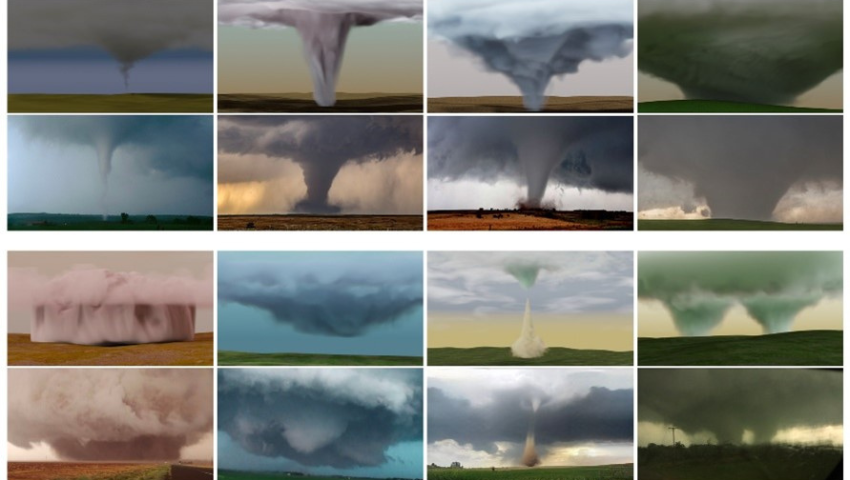Image Credit:Figure from Amador Herrera et al. (2024), Cyclogenesis: Simulating Hurricanes and Tornadoes, ACM Transactions on Graphics, 43(4), 1–16. © 2024 ACM, used with permission.
No matter the area of interest, discipline, or format your work may consist of, SIGGRAPH is the apex of innovation that is propelling our future and even the future of climatology. In this blog, we sat down with SIGGRAPH 2024 Technical Papers contributor Jorge Alejandro Amador Herrera to discuss how his work “Cyclogenesis: Simulating Hurricanes and Tornadoes” is playing a role in advancing the study of climatology.
SIGGRAPH: Your project “Cyclogenesis: Simulating Hurricanes and Tornadoes” proposes a physically based approach to describe the 3D development of cyclones in a visually convincing and physically plausible manner. What was the inspiration to pursue developing this idea?
Jorge Alejandro Amador Herrera (JAAH): I have always been fascinated by natural phenomena, particularly those involving multi-physics and multi-scale interactions. Beyond my personal interest, studying natural disasters is more crucial than ever due to the increasing impact of climate change. Understanding how these extreme events develop is essential, and computer graphics provides powerful tools to tackle this challenge.
By leveraging the strengths of graphics-based simulations — such as handling complex geometrical domains, enhancing visualization of physical quantities, and efficiently managing intricate interactions through GPU-accelerated computation — we can gain deeper insights into the life cycle of atmospheric cyclones, from their formation to dissipation.
SIGGRAPH: Whether it was capturing heat and water continuity or other aspects of your work, there may be a good amount of trial and error. Can you discuss any roadblocks you encountered while working on this project? How did you overcome them?
JAAH: In complex atmospheric systems, multiple physical models exist, each emphasizing different aspects of the phenomenon across various spatial and temporal scales. The main challenge was identifying the core physical mechanisms driving cyclogenesis and then formulating a physics-based approach that accurately captured these dynamics while remaining computationally efficient for real-time interaction. To overcome this, we carefully analyzed the underlying physics and gradually introduced additional couplings into our formulation, evaluating their individual effects on the overall simulation. This step-by-step approach allowed us to refine our model while ensuring both accuracy and performance.
SIGGRAPH: During the time spent creating, modifying, and perfecting your work, what would you say was your favorite part of that journey? Was there an “aha!” or lightbulb moment that you experienced during your work?
JAAH: One of the most fascinating aspects of tornado formation is its asymmetric development — while the wind field primarily drives an updraft, the tornado itself forms downward, from the sky to the ground. This behavior cannot be replicated by simply solving standard fluid dynamics equations, as seen in traditional smoke simulations. Instead, it requires dynamically coupling thermodynamic processes, where pressure drops lead to cloud condensation in the opposite direction of the vertical wind field. The moment we successfully simulated tornadogenesis with this asymmetry using our thermodynamic coupling was truly an “aha!” moment for me — it was both exciting and deeply rewarding.
SIGGRAPH: How does your work advance the study of climatology? What does this research tell us about hurricane and tornado phenomena?
JAAH: Our work advances the study of climatology by accurately capturing the key physical mechanisms responsible for cyclone formation, allowing for a deeper understanding of these extreme weather events. Moreover, unlike traditional climatology models, which require days of computation on supercomputers, our framework runs in real-time, enabling us to stream live atmospheric data directly into our solver. This capability allows for on-the-fly analysis of tornado and hurricane formation.
We demonstrated this by inputting historical data from Hurricane Katrina (2005) and successfully simulating its overall evolution from a given set of atmospheric measurements. By bridging forecasting and nowcasting techniques, our research has the potential to enhance disaster preparedness policies and response strategies, ultimately improving decision-making during extreme weather events.
SIGGRAPH: Technology in this field is rapidly evolving each day. Are there any major plans to grow your work?
JAAH: Understanding complex climate processes is more critical than ever due to ongoing climate change and its far-reaching impacts. Moving forward, I aim to continue exploring high-fidelity simulations that reveal unprecedented details of these phenomena, particularly those involving intricate multi-physics couplings. By advancing the accuracy and efficiency of such simulations, we can gain deeper insights into climate dynamics and their real-world implications.
SIGGRAPH 2025 is filled with opportunities to present you work to a global audience. Discover the exciting SIGGRAPH 2025 programs still accepting submissions, and find the ideal fit for your work.

Alejandro is a Ph.D. student in Applied Mathematics and Computational Sciences at KAUST, advised by Prof. Dominik L. Michels. His research focuses on computational methods in computer graphics, particularly physical simulation, data-driven approaches, and interactive modeling, with applications in artificial intelligence, machine learning, and numerical analysis. Previously, Alejandro earned dual degrees in physics and mathematics from UNAM, where he researched high-performance computing algorithms for molecular dynamics and high-energy physics. He has interned at Adobe and CERN, contributing to projects on physically-based hair simulation, deformable signed distance fields, and anomaly detection in particle collision data.



